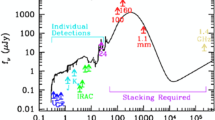Abstract
Stellar masses of galaxies are derived from the K-band (2.2 μm) photometry by taking into account evolution and cosmological effects with the code PÉGASE. The evolution scenarios are robust: they give reference spectra for valid photometric redshifts and fit the deepest galaxy counts with the standard cosmological model. Baryonic masses of the progenitor gaseous clouds are then derived. The baryonic maximum value Mbar,max = 1012 M⊙ fits the radio galaxy K-z sequence from z = 0 to 4. Since this cut value is observed at all z in the Hubble diagram, it favors a physical origin: i.e., the fragmentation limit of 1012 M⊙ predicted by Rees & Ostriker, 1977. One consequence is the discovery of high mass (≃ 1012 M⊙) galaxies at z ≥ 4, constraining the mass accumulation time-scales (Rocca-Volmerange et al. 2003).
Similar content being viewed by others
Author information
Authors and Affiliations
Editor information
Rights and permissions
About this paper
Cite this paper
Rocca-Volmerange, B. Galaxies of 1012 M⊙ at z ≥ 4 Along the K-z Sequence. In: Renzini, A., Bender, R. (eds) Multiwavelength Mapping of Galaxy Formation and Evolution. ESO Astrophysics Symposia. Springer, Berlin, Heidelberg. https://doi.org/10.1007/10995020_105
Download citation
DOI: https://doi.org/10.1007/10995020_105
Published:
Publisher Name: Springer, Berlin, Heidelberg
Print ISBN: 978-3-540-25665-6
Online ISBN: 978-3-540-31641-1
eBook Packages: Physics and AstronomyPhysics and Astronomy (R0)




